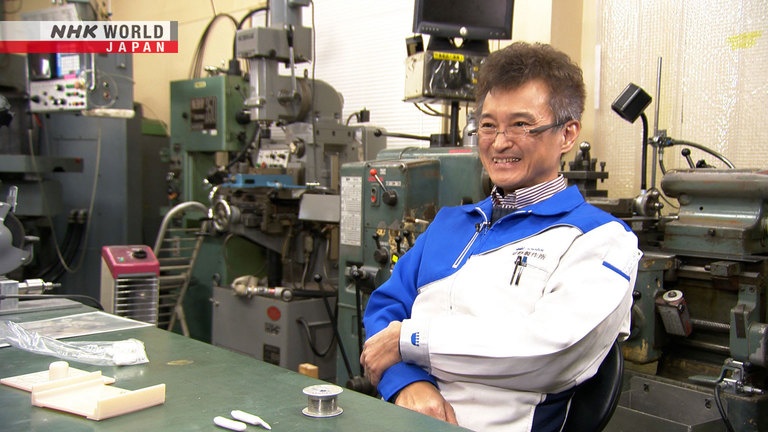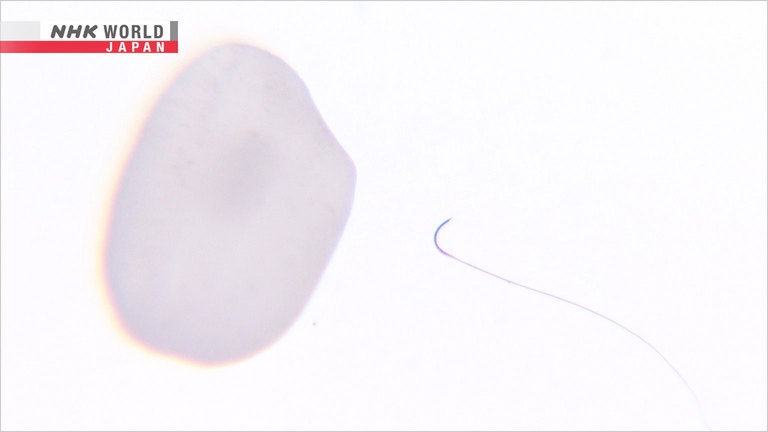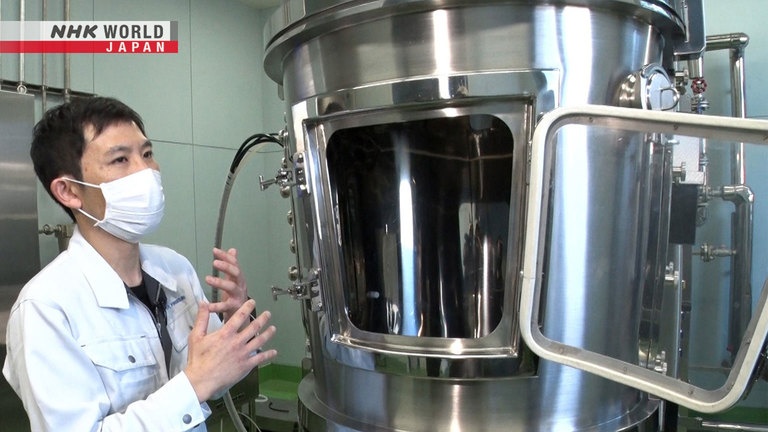Surgical Needles / Pharmaceutical Manufacturing Equipment
The fascinating stories and secrets behind hit Japanese products, plus parts and machines that boast the top share of niche markets. In the first half: the story behind the world's smallest surgical needles—only 0.03mm in diameter. In the second half: pharmaceutical manufacturing equipment essential for making pills. They apply coatings which allow easier ingestion and controlled release of the medicine. We go behind the scenes with the Japanese company that develops this equipment.



Transcript
"Japan's Top Inventions"
The behind-the-scenes tales of hit products and creations from Japan.
This is "Japan's Top Inventions."
On today's show,
extremely small surgical needles capable of suturing fine blood vessels.
They're used in the most advanced surgeries.
We'll show you what went into making them!
Later on the show, pills.
They play an important role in our healthcare.
We share the latest Japanese tech used for making them.
Hello, welcome to "Japan's Top Inventions."
I'm your host, Jason Danielson.
In the first half of our show, "Behind the Creation,"
we go behind the scenes and discover how Japan's top inventions were made.
Today's topic is this!
No, no, not the black sesame seed.
It's the thing next to it. Can you see it?
Only 0.8 millimeters long,
the world's smallest surgical needle,
developed by a Japanese company in 2004.
It's used for microsurgery -
procedures that are done while looking through a microscope.
This needle enabled operations that were previously impossible.
Development of these
began with the desire to address medically underserved populations.
A medical tool manufacturer in Chiba Prefecture.
This is the room where they package their products.
They're sealed in these pouches and shipped all over the world.
Here they are.
Surgical needles with the thread pre-attached.
Different sizes have different uses.
But the one at the top here is only 30 microns in diameter,
0.03 millimeters, the smallest in the world.
You can get a sense of scale with it next to a grain of rice.
The rice is about 5 millimeters long,
so the needle is truly tiny.
Even a gentle breeze from the air conditioning can blow it away.
Our story begins back in 2001.
Japan was one of the most medically advanced countries in the world.
Advances in the field of microsurgery were occurring.
Damaged tissue could be repaired
using healthy tissue from another part of the body,
with blood vessels being connected while viewed through a microscope.
Such delicate operations required great skill and special equipment.
A manufacturer in Chiba commanded a large share of the market
for needles used in microsurgery.
The company started out making clock hands
but moved into the medical field in the 60s.
They continued to develop their surgical needles over the years.
Then one day, the company received a call
from a doctor at a university hospital.
"I want a smaller and thinner needle," he said.
"Can your company make one for me?"
Microsurgical techniques were advancing
and small blood vessels were being connected.
The needles the company made
only worked for blood vessels that were at least 0.5 millimeters in diameter.
Any thinner, and surgery could not be done.
This gave rise to medically underserved populations.
This is Kono Junichi, president of the company.
Here's how he remembers things.
There was a population that couldn't have surgery done
because the blood vessels in the affected area were too thin.
We thought we should use our company's skills and passion
towards finding a solution.
We weren't thinking about profit or the numbers.
The company wanted to eliminate this medically underserved population.
Kono decided to immediately start development of a new surgical needle.
Development of this new needle
was to be led by experienced engineer Iwadate Tsutomu.
Since joining the company,
he'd worked on the production process for surgical needles.
Developing the new needle was an exciting prospect.
I thought we'd give it our best shot.
It was a chance to see how small we could make it with our technology.
Honestly, though, it was a bit daunting.
Iwadate got straight to work.
The first order of business was seeing how thin the needle should be made.
The body is filled with blood vessels.
Certain vessels have an inner diameter of 0.1 millimeters.
In order to suture these,
the needles had to be 0.03 millimeters -
less than a third of the inner diameter.
But 0.03 millimeters had never been done before.
How could such a tiny needle be made?
The company looked towards this -
stainless-steel thread.
The thinnest thread that was made was 0.05 millimeters.
If this could be made even thinner, perhaps it could be used for the needle.
The first method that was attempted was electropolishing.
The stainless steel thread is placed in a special solution.
Then a current is applied.
Through an electrolytic reaction, the surface of the thread is dissolved.
But a closer look at the surface of the thread revealed a problem.
The reaction worked, but it created a bumpy and uneven surface.
It came out bumpy.
While it was thinner, it wasn't an even shape. It had peaks and valleys.
I'd have to find another way to get it to 0.03 millimeters.
Was there another method?
Iwadate fervently researched his options, and then, a thought.
Iwadate prepared two blocks.
The stainless steel thread would be placed in between,
and then rolled.
After repeating this motion,
the thread inside snapped.
But, had it become thinner?
Iwadate put the thread under the microscope.
Upon close inspection, a section had become 0.03 millimeters.
That piece could be cut out and used to make the needle.
If I had about three centimeters, I could make a needle.
I could tell that much just by looking.
I checked by eye, measured, and thought it was good.
Iwadate removed the usable portion.
But he soon ran into another problem.
How could the tip of the piece be sharpened?
If it wasn't sharp, it wouldn't work as a needle.
But the thread was thinner than a hair.
So what could be done?
Iwadate had hit a wall.
A needle capable of suturing very fine blood vessels.
While the stainless steel thread had been made thin enough to use,
the tip still needed sharpening.
But a needle only 0.03 millimeters in diameter
was completely new territory.
Finding a way to sharpen it would be incredibly difficult.
How to sharpen the tip.
Some kind of grinding tool was needed.
Iwadate created his own custom grinder and tried the thread on it.
Then, he viewed the tip under a microscope to verify the shape.
This process was repeated over and over again.
Finally, one day, the tip appeared sharp enough under the microscope.
But would it work?
He tried the test piece on some paper.
It cleanly pierced the sheet.
Watching the action through a microscope,
I could see it slip right through the paper.
There was no resistance.
That was when I knew I'd done it.
It could be used as a needle.
But just as he was about to celebrate,
there was one more hurdle to overcome.
How to thread the needle.
The surgical needles are shipped out with thread pre-attached.
Until then, a laser had been used to open a hole for the thread to go into.
But at only 0.03 millimeters,
the laser would melt the back of the needle instead.
Iwadate searched diligently for a way to attach the thread.
He came up with something to try.
He would use a press to flatten the end of the needle,
set the thread onto the surface, and then pinch it all together.
Iwadate activated the press.
The end became less than a hundredth of a millimeter thick.
Looking through the microscope,
he pinched the thread on using a set of tweezers.
Was it secure?
He gave the thread a tug,
and...
it slipped right out.
The issue was the mold used for the press.
The needle is set in this cavity and pressed from above.
But this shape proved too loose to hold the thread.
Iwadate had an idea: to add grooves.
The thread would embed into the grooves after being pressed in.
Adding the grooves required days of fine adjustment
to the special shape of the mold.
But even after many tries, the thread failed to catch in the grooves.
This was going to be a marathon.
Iwadate prepared himself for the task.
He would stay over at work, dedicating his time to making the adjustments.
Things weren't going smoothly.
I worked day and night, sleeping in a sleeping bag on a piece of cardboard.
It was a matter of mere decimals.
A few microns here and there on the mold.
I kept on adjusting.
Finally, the mold with the grooves was complete.
If the thread still slipped out,
then the dream of the world's smallest needle would be over.
Nervously, he pinched the end closed, and pulled on the thread.
The thread...
was secure.
It was finally done.
What a process it had been.
There are cases of infants or toddlers
losing a finger in household accidents,
but with a needle this small, they could get surgery.
It could really make a difference.
And so, in 2004,
the world's smallest surgical needle was finally finished.
It was first used to reconstruct the palm of a hand,
suturing blood vessels only 0.3 millimeters in diameter.
After this initial success,
other hospitals in Japan gradually came to adopt the needles.
And that was how the world's smallest surgical needle was made.
Finer blood vessels could now be sutured,
enabling new treatments for many patients.
What do doctors have to say about these surgical needles?
We're joined by Kuroshima Nagatsugu,
the doctor who put forward the request to have them made.
Hello, Dr. Kuroshima.
Thanks for having me.
What prompted you to ask for needles this small to be made?
Until that point, it was mainly blood vessels
three or four millimeters wide that were joined under a microscope.
These were all major blood vessels that had medical names,
but when you got down to the smaller ones that didn't have names,
there was no surgery that could be done for them.
The existing tools and microscopes were not suitable.
We needed something totally new.
That was the motivation.
What kind of surgeries have you used them for?
With this 0.03-millimeter needle,
you can transplant skin and bone as well.
You can even transplant cartilage, joints, and nails.
It's very versatile.
The response of the needles as you pass through the blood vessel
is incredibly important.
It's astonishing that it's this easy to use
even while being the smallest in the world.
What impact have these needles had in the field of microsurgery?
For transplant surgery, these needles have reduced scarring by 90 percent.
Surgery time is much shorter.
The wounds from the surgery are closed up nicely.
It's made a dramatic difference.
In December 2021,
at a meeting for microsurgeons in Japan and the Asia-Pacific region,
we received reports of brilliant operations
being performed in Korea and Turkey.
I think the impact of these needles is just going to continue to grow.
Thank you for your time. Great talking to you.
Thank you.
"Top Niche Creations"
In the second half of our show, "Top Niche Creations,"
we discover Japanese products doing well in niche markets worldwide.
Today, we're looking at this device.
It's got some kind of viewing window built into it.
This is how it looks in action.
Something's tumbling in there, almost like in a laundry machine.
Actually, this is part of the process to create something
that's very important to our healthcare.
Just what is it for?
We went to find out!
The factory of a machine manufacturer in Shizuoka.
Since the company's founding in 1964,
they have continued creating these devices.
Just what exactly do they do?
We asked Misono Hayato, who works in engineering, to find out.
Our company's device is used for making things like medicine
or supplements and other similar products.
The medicine that can be found in drug stores around the world.
These pills can be many shapes and colors.
They're made using something called a granulating machine,
which this company manufactures.
How exactly does this machine make pills?
We were given a special look at how it works.
This is a white powder that is used for demonstrations.
The powdered ingredients for medicine are so fine that they stick to the hands.
This powder is loaded inside and the machine is turned on.
Let's take a look.
A cloud of white forms inside.
Hot air is blown in the chamber, and the powder begins to fly around.
Then, this is applied inside.
A binding agent sprays out.
The powder begins to stick together.
They form into grains, getting bigger and bigger
until they reach the target size.
Then the device is stopped.
After the binder is added, the machine is left to run.
What was once stuck to the window begins to come off.
The fine powder is mixing with the binder, and forming larger grains.
What's happening?
The powders swirl inside the machine.
They can be up to several tens of microns in size.
As the different powders mix,
the binders cause them to stick together,
until the grains are about ten times larger than before.
Once these are pressed, they turn into the pills that we're used to.
These are the finished grains.
The machine has been running about two hours.
When touching the finished grains, you can see it no longer sticks together.
The difference from the original powder is clear.
These are what the pills look like after being compressed.
To finish them, they are then placed inside another device
called a coating machine.
The power is turned on.
The pills begin tumbling inside.
Something is sprayed onto the pills during this stage as well.
It's actually an artificial sweetener used to coat the surface of the pills.
After some time, the pills become coated in the brightly colored sweetener.
Here are the finished samples.
This is a cross-section of a real pill.
The coating is clearly visible when viewing it through a microscope.
The purpose of the coating is to mask the taste or smell of the medicine.
The thin layer of sweetener, just microns thick,
is very effective at doing this.
It hides the bitter taste of the medicine when ingesting the pill.
For over 50 years, this company has been improving their coating technology.
Now, the timing of the release of the medicine can be controlled
by adjusting the coating.
For example, a probiotic bifidobacteria supplement with a double coating.
The outer layer resists the stomach acid, dissolving in the small intestine,
while the inner layer holds until the large intestine,
delivering the bacteria to its destination intact.
By adjusting the coating, the time before the medicine takes effect
can range from 30 seconds after ingestion to dozens of hours later.
The machines have been used in over 70 countries and regions worldwide.
The company is one of the top three manufacturers of these machines globally.
Their newest model is even capable of this:
printing a QR code onto the pill.
This technology was developed in order to reduce errors at the pharmacy
and to prevent counterfeits.
Pills that are safe and easy to swallow.
The company continues to develop their technology for the world.
Our machines help make new medicines.
And that's something that helps a lot of people.
We're working behind the scenes to help support
health and medical care all around the world.
That's the goal of our work here at the company.
Time for a pop quiz!
The machine we just showed you is actually used for more than just medicine.
It can also make a certain kind of food.
I'll give you a hint.
It's a sweet that's round, colorful, and has a coating.
You think you got it?
That's right.
Candy-coated chocolates!
They do look a bit like medicine, don't they?
Forming different elements together and coating them.
Who would have thought the machines could also be used in this way?
That's all for today's "Japan's Top Inventions."
We'll end by showing you what the engineer who developed
the surgical needle from the first half of the show has worked on since.
Thanks for watching.
See you next time, and stay inventive.
(Iwadate developed the world's smallest surgical needle.)
(He's created many other medical tools with other doctors since.)
(This is a clip that halts the flow in blood vessels.)
(And this is a mesh made of suture thread for application on wounds.)
(The lessons he learned from making the needle remain with him today.)
You can do it if you keep trying.
If you can keep up that attitude every day, anything is possible.